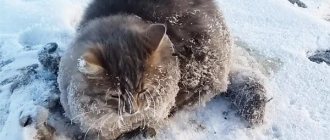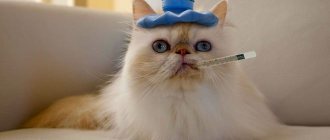Low temperature in a cat - causes and what to do
We all love our pets and worry when something is wrong with them.
One of the symptoms of serious illness in an animal may be low body temperature. The thermoregulation center is located in the brain, or more precisely in one of the parts of the medulla oblongata (hypothalamus). The normal body temperature of an adult cat is recorded in the range of 37.8 – 39.2 °C, in kittens – from 38.3 to 39.7 °C.
The scientific name for a condition characterized by a drop in body temperature is hypothermia.
There are three stages of the disease:
- Mild (body temperature 32 – 35°C);
- Moderate (temperature drops to 28 – 32°C);
- Deep (body temperature below 28°C).
A decrease in body temperature leads to centralization of blood circulation. Blood rushes to the brain and heart, protecting them first, and peripheral blood flow decreases at this time. Metabolic processes slow down and the body's defense mechanisms turn on (muscle tremors, fur fluffs up, breathing slows down).
The acid-base ratio in the blood changes, hypercapnia develops (increased carbon dioxide content), then interstitial and interstitial fluid rushes into the alveoli. In this case, the process of cellular respiration is disrupted, and the supply of oxygen to the tissues is insufficient. Against the background of pathological processes occurring in the body, blood clotting is impaired and pulmonary edema develops.
Specialized assistance
The best solution when identifying signs of hypothermia in a pet is to contact a veterinarian. It is necessary to find out the cause of the disease in an animal rescued from the street and in your cat, and carry out a number of diagnostic measures:
- Examination by a specialist.
- Collection of tests.
- X-ray of the chest and abdominal organs.
- Ultrasound examination of the abdominal organs.
- X-ray of skeletal bones.
Depending on the severity of the condition, when examining the animal, the doctor will detect a decrease in heart rate, an irregular heart rhythm, a decrease in blood pressure, a decrease in the amount of urine excreted, changes in breathing - it becomes superficial and rare. The animal reacts sluggishly or not at all to inspection; consciousness may be absent.
In severe cases, breathing practically stops, single breaths appear, foam may appear at the mouth (a sign of pulmonary edema), lack of consciousness, pulse and blood pressure may be barely noticeable or not detectable.
The doctor prescribes intravenous infusions with warm solutions, medications that relieve symptoms of the underlying disease, and oxygen therapy. The clinic staff constantly monitors the cat’s vital signs.
For more severe hypothermia, internal warming is performed: the stomach is washed with warm solutions, enemas with heated solutions, and inhalation of warm air.
In case of clinical death, the animal begins to be resuscitated immediately. If the measures are not successful, the death of the animal can be declared if the body temperature is above 30 – 32°C. Surviving patients, especially old ones, may have consequences in the form of impaired brain function, a shift in the point of thermoregulation, and cardiovascular failure. Some experts believe that animals that have experienced severe hypothermia are more likely to experience repeated episodes of hypothermia.
Fever
The normal temperature for a cat is considered to be 38-39.2 degrees Celsius. An increase in this indicator by a degree or more already indicates that the pet is unwell. The first symptom of the onset of the disease can be called lethargy and when the pet does not eat anything for a long time. Also, the cat may constantly lie down and refuse any communication. Although, there are cases when the symptoms are the opposite - the pet, on the contrary, is overly active, has increased thirst and eats constantly.
High fever in cats can also provoke symptoms such as vomiting, dilated pupils, constipation, irregular pulse and breathing. There may also be discharge from the ears, eyes and nose. In most cases, an elevated temperature in a cat causes only a couple of symptoms. A sick animal's fur often becomes dull and bristles in different directions.
When signs of fever appear in a cat, it is necessary to carry out an examination in order to quickly understand its cause. It’s worth starting with the fur and seeing if there is any discharge from the animal’s nose. You also need to look into the oral cavity. In a healthy cat, it is pale pink, there is no stomatitis or ulcers. Feeling the abdomen will help determine the condition of the gastrointestinal tract. After all, it is precisely because of such diseases that a sick pet does not eat anything.
We measure the temperature
A cat's fever can be measured using a rectal thermometer. If this is not the case, you can use the usual one. It will be more convenient if the animal is standing, but you can measure the heat of a sitting or lying cat. Next, you need to lubricate the tip of the thermometer with Vaseline or ordinary oil. Then lift the furry tail and carefully insert it into the rectum about three centimeters. For more information on this procedure, see the video below.
In a couple of minutes you can get exact numbers. The kitten's temperature is 40 degrees, what should I do? Try to find out what the reason is, although in any case you will have to take him to a specialist. When a cat’s fever rises to 40 degrees, postponing a trip to the veterinarian is dangerous. Thus, high temperatures negatively affect the pet’s health, causing problems such as dehydration or cerebral edema.
Reducing the temperature correctly
You should not try to reduce a fever of 40 degrees or higher at home with antipyretic drugs intended for humans. Only in the most extreme cases, if the veterinarian does not arrive soon, and the cat’s high temperature has risen above 40 degrees, is the pet given Analgin. However, the best way to reduce the fever is through physical methods, such as placing ice on your inner thighs or neck. Alternatively, you can wrap your pet in wet gauze.
The most correct decision when a cat’s temperature rises is to urgently take the pet to the veterinary clinic.
Why is it better not to call a veterinarian at home, but to immediately take a pet who has a fever to the clinic? The fact is that the animal’s high body temperature could be caused by a variety of viruses. They can only be identified by passing the necessary tests. This way, you can gain valuable time to save your pet’s life.
How else can you bring down the temperature?
- The cat does not eat anything, so the best option would be if you offer him something to drink.
- Use a fan to reduce the heat, but you will have to be careful to make sure your pet doesn't get blown out.
- Lubricating the seals' paw pads with vodka can also help reduce the fever. The period of wiping during this treatment is once an hour.
- In case of heatstroke, you should not try to reduce the fever; be sure to take your cat to the doctor.
Massage and diet
During periods of high fever, the animal must be fed only dietary food. You cannot overfeed or force it. The main thing is that the cat drinks as much water as possible.
Note! Food should only be liquid, for example, you can offer your pet low-fat chicken broth. Vitamin C must be added to the diet to boost immunity
It helps the body fight inflammation. During illness, you can give your cat a mixture of yogurt, ascorbic acid and cottage cheese. Adults are given up to 500 mg of ascorbic acid per day
Vitamin C must be added to the diet to improve immunity. It helps the body fight inflammation. During illness, you can give your cat a mixture of yogurt, ascorbic acid and cottage cheese. Adults are given up to 500 mg of ascorbic acid per day.
Massage has a positive effect on reducing temperature. You need to knead the point under the knee bend on the outside of the hind leg for two minutes. Then you can lightly massage your entire body. The main objective of the procedure is to enhance blood activation. This will help speed up the healing process.
Massage to reduce temperature
Reasons for the drop in temperature
Most often, a decrease in an animal’s body temperature occurs as a result of hypothermia. In this sense, the situation is especially dangerous for animals when it is very humid outside. Then the wool is saturated with moisture. The air that circulated between the fur and skin disappears. The air acted as a kind of buffer between the pet’s skin and the cold surrounding air and prevented the animal from freezing.
Small kittens and older animals are more susceptible to hypothermia, that is, those categories that cannot maintain normal body temperature for a long time under unfavorable conditions.
In addition to unfavorable environmental factors, various pathological conditions can also lead to a decrease in an animal’s body temperature. For example, prolonged malnutrition and exhaustion one of the symptoms is low temperature. At the same time, the animal is emaciated and inactive.
Older cats suffering from severe liver and kidney disease may have low body temperature as one of their symptoms.
Bleeding, especially massive bleeding, causes a decrease in the animal’s body temperature. External bleeding is obvious. Arterial bleeding is especially dangerous. In this case, the animal quickly dies without assistance. Internal bleeding can be noticed by the appearance of blood in the urine or stool.
Diseases of the heart and blood vessels can cause a decrease in a cat’s body temperature. Symptoms depend on the specific disease. This can be a variety of arrhythmias, shortness of breath, deterioration in the pet’s general condition, and blue discoloration of visible mucous membranes.
Viral infections that occur with suppression of the immune system may occur with a decrease in the animal’s body temperature, instead of the usual fever. An oncological process can lead to a decrease in body temperature.
Nervous diseases in cats may be accompanied by a decrease in body temperature. At the same time, the animal's behavior changes. We're not talking about games.
Hair loss on the belly and between the hind legs is a result of intense licking
Veterinarians often determine the cause of hair loss by the location of the bald spot. It is believed that the most likely factor for hair loss on the stomach and hind legs of a cat is excessive licking.
If bald patches appear on your pet's stomach, it is necessary to examine areas of skin without hair. The condition of the skin on them will tell you what could cause the pathology. Normally, the skin will be smooth, soft, without redness or scales.
Sometimes when examining an animal, fleas are discovered. In this case, alopecia is explained by intense scratching and licking of flea bites (visible in open areas). Hair often falls out due to allergies to saliva and insect secretions.
Elderly animals intensively lick their paws in the joint area due to pain in them. Many older pets face this problem.
Treatment
If your pet is shivering and huddling close to the heaters, he is most likely freezing. A frozen cat needs to be warmed up. If an animal freezes outside, it must be brought into a warm room, wrapped in a warm blanket and placed in a place where there are no drafts. If the cat has mild hypothermia, passive rewarming will be sufficient. If the animal has wet fur, it needs to be dried. You can use a hairdryer. When the animal warms up a little, stops shivering, its body temperature rises to 37.2°C, you can offer it a warm drink and some food.
With prolonged exposure to the cold and severe hypothermia, these measures will not be enough. It is better to take the animal to the veterinarian. It needs to be warmed up along the way. You need to wrap the cat in a warm blanket, you can use heating pads. In this case, at the veterinary clinic the animal will be given a warm enema and placed on a drip with a slightly warmed solution. For any degree of hypothermia, the animal must be shown to a doctor. Because hypothermia can lead to inflammation in the kidneys or membranes of the brain, pneumonia and other diseases can develop.
If there is no hypothermia, but the animal’s body temperature drops, it should be wrapped in a warm blanket, covered with heating pads if necessary, and taken to a doctor for examination.
Fever and chills in cats: treatment features
In cats, like in other animals, with any ailment, the temperature rises or falls. This is the first signal that your pet needs immediate help. The cat tolerates any temperature deviation from the norm very poorly. As a rule, the animal does not eat or drink anything and lies quietly in a secluded place. What to do if your cat’s temperature rises or falls, and why can this happen? Let's talk about this now.
Reducing the temperature correctly
We recommend reading: Kitten's Breath Smells From Natural Food
Stabilizing the temperature of cats
Video “Cat sneezes”
Comments and Reviews
Causes of elevated temperature and what to do
Hyperthermia occurs due to external and internal irritants, most often under the influence of the following factors:
- Viral diseases. The immune system reacts to pathogenic microorganisms by increasing the temperature, so the bacteria die faster. In cats, panleukopenia or distemper, rhinotracheitis, calcivirosis, and coronavirus are more common. It is possible to protect your pet from these diseases, except for the last one, by vaccination.
- Inflammation. Pathogenic bacteria enter the body when wounds and stitches after injury or surgery heal slowly or are carelessly treated.
- Overheat. Heat transfer is impaired in a stuffy, hot room, car or in direct sunlight. Kittens and older cats are more likely to suffer from overheating.
- Stress. Thermoregulation disorder sometimes begins in stressful situations: when traveling in transport, changing place of residence, visiting a veterinarian.
- A temperature jump of within 1 degree occurs after sterilization and vaccinations. In the first case, this is a reaction to surgery, in the second, it is protection against viruses that enter the body with the vaccine. Increased levels last for 3 days; If the fever does not subside for longer, it is better to take your pet to the veterinarian.
With hypothermia, blood flow is directed to the heart and brain, and in other parts of the body is reduced, resulting in a slower metabolism.
Here are the conditions in which hypothermia begins:
- Hypothermia after being in the cold with high humidity often occurs in older people and in kittens.
- Weakened state: exhaustion from malnutrition.
- Disruption of internal organs: pathologies of the heart and blood vessels, kidneys and liver, endocrine system
- Viral infections, if the disease occurs against a background of suppressed immunity.
- Blood loss: occurs after serious cuts, surgical operations, but internal bleeding due to bruises, falls, and illnesses is more dangerous. Owners often do not notice this and do not help the pet.
- Helminthiasis: against the background of infection with parasites, anemia, exhaustion develops, and thermoregulation is impaired.
The owner can know for sure about hypothermia; other causes cannot be identified without veterinary education and special examination.
After you have measured the temperature, you need to compare it with normal.
1) First of all, this is hypothermia. If your pet has spent a lot of time indoors/outside with low temperatures. At the same temperature, different animals react differently. How far the animal will freeze will depend on the breed and age of the cat.
2) Anesthesia. After operations with anesthesia, the cat's temperature may drop as well as in deep sleep.
3) Injury and shock. If your pet has just been injured or has suffered severe stress, its body temperature may drop temporarily.
4) Diseases associated with the cardiovascular system. If there is a disturbance in the functioning of the heart or poor functioning of the blood vessels and a decrease in pressure, a constant low temperature is also observed.
What to do when the temperature drops?
Try to warm the animal. Wrap the cat in a blanket, blanket or towel, apply a heating pad or give warm water/soup. Under no circumstances should you try to warm an animal in hot water! A sudden change in temperature can cause heart problems!
If the temperature is too low or cannot be raised within a couple of hours, and also if the above reasons are not present, then you should contact the nearest veterinary clinic for testing!
An increase in temperature is very dangerous for cats, as it leads to a decrease in the amount of fluid in the body and disruption of the functioning of internal organs. Most often, elevated temperature indicates inflammatory processes. At a temperature of 40-41C and above, immediately contact your nearest veterinary clinic!
1) Various infectious diseases. From a simple cold to viral and fungal infections, when the body tries to fight them by raising the temperature. Be sure to consult a doctor to get tested and identify a specific disease.
2) Poisoning. Often, in addition to disruption of the digestive system, the temperature also rises.
3) Oncological diseases. One of the symptoms is a constant increase in temperature.
4) Metabolic disorders. For example, older cats may have problems with the glands that are responsible for removing fluids and moisturizing mucous membranes.
5) Reaction to medications or allergens. If you have given your cat any medicine, check for side effects such as fever.
6) Inflammation of the gums, ear or nose diseases. Very often, inflammatory processes in the ear-nose-throat system lead to an increase in temperature.
When the pet's thermoregulation system is disrupted, its body temperature rises. This indicates the beginning of the incubation period of the disease or its absence.
There may be several reasons:
- viral infection, the appearance of harmful microbes or parasites in the animal’s body;
- intoxication;
- stress factor;
- prolonged physical activity or pregnancy.
Studying the symptoms and the attentive attitude of the owner towards his pet will help to complete the overall picture.
Symptoms and first aid
You notice that your cat's nose is dry and hot to the touch - this is a signal of hyperthermia. The exception is elderly individuals whose cooling glands function poorly.
When the temperature rises, the pet may experience a feeling of weakness, move sluggishly, or not get up from its place. The pulse quickens, breathing becomes heavy and intermittent. Perhaps the animal will tremble, and a film in the form of a third eyelid will form on the eyeball.
With hyperthermia, the animal often refuses to eat and drinks almost no liquid, which can lead to dehydration. If many symptoms are present, the pet needs urgent treatment and your help.
A decrease in temperature in cats manifests itself in the following symptoms:
- trying to snuggle closer to the warmth;
- convulsive movements, fever;
- apathy, depressed state;
- pallor of the mucous membrane;
- tousled hair.
Providing first aid to an animal begins with the need to lay it on a level place and wrap it in a warm blanket. It is advisable to give plenty of fluids, but do not feed for several hours.
It is recommended to give your pet an alcoholic drink in small doses. You can pour one or two ml of vodka or diluted alcohol down his throat using a syringe to destroy germs. If you notice that there is no improvement, contact your doctor.
In case of hyperthermia (high temperature), the cat is taken to the veterinarian; if you can’t show your pet to a doctor, bring down the fever by at least tenths of a degree.
The condition can be alleviated by the following actions:
- increase indoor air humidity;
- moisten the wool with water or wrap it in a wet towel;
- put ice on the inside of the thighs, neck or behind the ears;
- drink cool water; if the pet refuses, use a pipette or syringe without a needle.
It is not allowed to treat the cat on your own or give medications. “Human” antipyretics and antibiotics cause kidney problems.
In case of hypothermia (low temperature) due to hypothermia, the pet is warmed up:
- placed in a warm place without a draft;
- wrapped in a blanket;
- cover with heating pads or containers with hot water;
- give a warm drink using a pipette.
If these measures do not help, the pet is taken to the clinic. There they give a warm enema and a drip with heated saline. If the cat is not hypothermic, but the temperature drops, the animal is wrapped up and taken to the doctor.
Temperature deviation from the norm is a clinical symptom of a host of diseases that only a doctor can identify and cure. The task of the cat owner is to find out the normal parameters of the pet, to recognize dangerous changes in external symptoms in time, to be able to measure and competently help.
Low temperature in a cat
Undesirable effects of hypothermia
Hypothermia should not be taken too lightly. With prolonged low temperatures, a cat may experience such undesirable consequences as:
- inflammation of the membranes of the brain;
- pneumonia;
- kidney disease.
As you can see, a low temperature in a cat, like any other disease, requires special care for the animal. Therefore, if you find the above symptoms, you should definitely consult a doctor. Such a seemingly simple disease should not be left to chance, otherwise it can even lead to the death of the animal.
If your pet suffers from low body temperature, then it is necessary, first of all, to warm it up. To do this you should :











